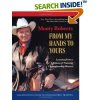Whether you have a horse to ride, drive or just as pasture décor here’s what it should know so both you and the horse are happy and safe.
1. Lead Quietly In Hand
When you lead your horse he should walk beside you quietly paying attention to you. When you ask your horse to back up, or step to the side he should float away from your cue like a rubber ducky being pushed in a bath tub, not like a brick being pushed through sand. Your horse shouldn’t pull you, barge ahead, hang back or push into you. Teaching your horse to lead properly is the basis for almost every other aspect of good manners.
3. Stand Quietly To Have Feet Handled
Horses need regular hoof care and they need their hooves trimmed every six to eight weeks. Teach your horse to stand quietly while you clean their hooves or while the farrier works with them. It makes the process much less stressful, (and less painful) for all involved.4. Accept Paste Wormers
Teaching your horse to accept paste wormers makes regular parasite control easier. It also makes the administering of other oral medications easier. 5. Get On a Trailer
A horse that won’t load on a trailer quietly isn’t just frustrating—it can be dangerous. You may not plan to leave your property with your horse. But that doesn’t mean it shouldn’t learn to get on a trailer. Emergencies can happen and you may have to take your horse to a vet clinic. Or you might change your mind about going to horse shows. And while you may never dream of selling your horse, the unexpected can happen. Often horses who don’t lead well, also don’t load well.6. Wait
I use the command ‘wait’ to tell my horses to wait until I completely open a gate or stall door before coming through, or to stand and wait while I put feed in the buckets. A horse that barges through gates or doors is dangerous to both handler and horse and it makes feeding a time a hassle if the horse is pushing in to get food. Even if your horse is just pasture decoration it will at some point need to be caught. There is nothing more frustrating than having planned an hour of riding, or training or other activity and have that time taken up pursuing your horse around the pasture. It can get costly too, if the farrier or veterinarian is waiting. Things can get dangerous if your horse feels cornered and the only escape is over top of you. Teach your horse to be caught each and every time you want it.
8. Stand Tied
Standing quietly to be tied, whether to a post, beside a trailer, a tree or in cross ties is essential. You’ll want to tie your horse to groom, clean hoofs, tack up or harness up, or just to keep him safely out of the way while you attend to other matters. Teach your horse to stand quietly while tied without fussing or pulling. Often horses that don’t stand quietly while tied don’t lead quietly eithe









.jpg)



No comments:
Post a Comment